Zihan Liu
GTR-Mamba: Geometry-to-Tangent Routing for Hyperbolic POI Recommendation
Oct 27, 2025Abstract:Next Point-of-Interest (POI) recommendation is a critical task in modern Location-Based Social Networks (LBSNs), aiming to model the complex decision-making process of human mobility to provide personalized recommendations for a user's next check-in location. Existing POI recommendation models, predominantly based on Graph Neural Networks and sequential models, have been extensively studied. However, these models face a fundamental limitation: they struggle to simultaneously capture the inherent hierarchical structure of spatial choices and the dynamics and irregular shifts of user-specific temporal contexts. To overcome this limitation, we propose GTR-Mamba, a novel framework for cross-manifold conditioning and routing. GTR-Mamba leverages the distinct advantages of different mathematical spaces for different tasks: it models the static, tree-like preference hierarchies in hyperbolic geometry, while routing the dynamic sequence updates to a novel Mamba layer in the computationally stable and efficient Euclidean tangent space. This process is coordinated by a cross-manifold channel that fuses spatio-temporal information to explicitly steer the State Space Model (SSM), enabling flexible adaptation to contextual changes. Extensive experiments on three real-world datasets demonstrate that GTR-Mamba consistently outperforms state-of-the-art baseline models in next POI recommendation.
ClusterFusion: Expanding Operator Fusion Scope for LLM Inference via Cluster-Level Collective Primitive
Aug 26, 2025Abstract:Large language model (LLM) decoding suffers from high latency due to fragmented execution across operators and heavy reliance on off-chip memory for data exchange and reduction. This execution model limits opportunities for fusion and incurs significant memory traffic and kernel launch overhead. While modern architectures such as NVIDIA Hopper provide distributed shared memory and low-latency intra-cluster interconnects, they expose only low-level data movement instructions, lacking structured abstractions for collective on-chip communication. To bridge this software-hardware gap, we introduce two cluster-level communication primitives, ClusterReduce and ClusterGather, which abstract common communication patterns and enable structured, high-speed data exchange and reduction between thread blocks within a cluster, allowing intermediate results to be on-chip without involving off-chip memory. Building on these abstractions, we design ClusterFusion, an execution framework that schedules communication and computation jointly to expand operator fusion scope by composing decoding stages such as QKV Projection, Attention, and Output Projection into a single fused kernels. Evaluations on H100 GPUs show that ClusterFusion outperforms state-of-the-art inference frameworks by 1.61x on average in end-to-end latency across different models and configurations. The source code is available at https://github.com/xinhao-luo/ClusterFusion.
AceReason-Nemotron 1.1: Advancing Math and Code Reasoning through SFT and RL Synergy
Jun 16, 2025Abstract:In this work, we investigate the synergy between supervised fine-tuning (SFT) and reinforcement learning (RL) in developing strong reasoning models. We begin by curating the SFT training data through two scaling strategies: increasing the number of collected prompts and the number of generated responses per prompt. Both approaches yield notable improvements in reasoning performance, with scaling the number of prompts resulting in more substantial gains. We then explore the following questions regarding the synergy between SFT and RL: (i) Does a stronger SFT model consistently lead to better final performance after large-scale RL training? (ii) How can we determine an appropriate sampling temperature during RL training to effectively balance exploration and exploitation for a given SFT initialization? Our findings suggest that (i) holds true, provided effective RL training is conducted, particularly when the sampling temperature is carefully chosen to maintain the temperature-adjusted entropy around 0.3, a setting that strikes a good balance between exploration and exploitation. Notably, the performance gap between initial SFT models narrows significantly throughout the RL process. Leveraging a strong SFT foundation and insights into the synergistic interplay between SFT and RL, our AceReason-Nemotron-1.1 7B model significantly outperforms AceReason-Nemotron-1.0 and achieves new state-of-the-art performance among Qwen2.5-7B-based reasoning models on challenging math and code benchmarks, thereby demonstrating the effectiveness of our post-training recipe. We release the model and data at: https://huggingface.co/nvidia/AceReason-Nemotron-1.1-7B
Astraea: A GPU-Oriented Token-wise Acceleration Framework for Video Diffusion Transformers
Jun 06, 2025
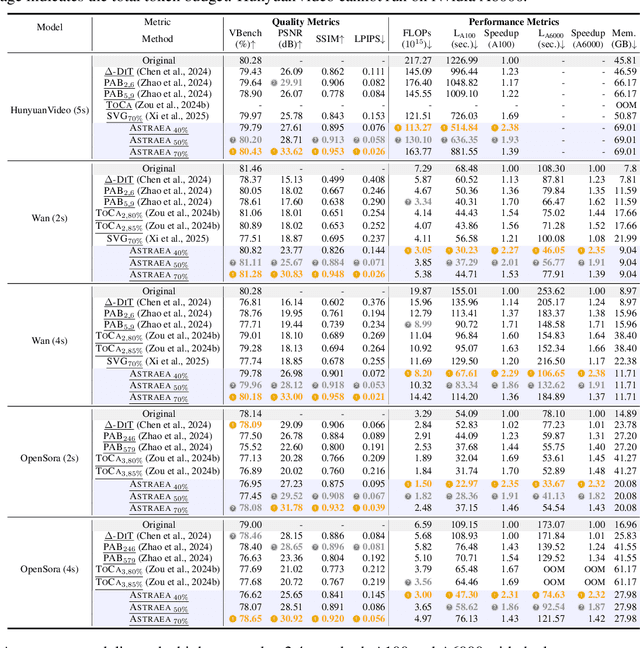
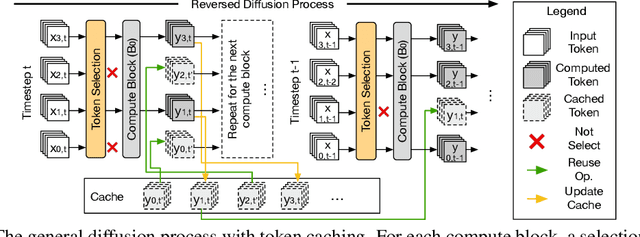
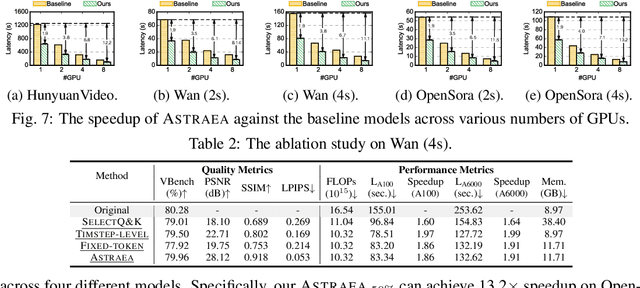
Abstract:Video diffusion transformers (vDiTs) have made impressive progress in text-to-video generation, but their high computational demands present major challenges for practical deployment. While existing acceleration methods reduce workload at various granularities, they often rely on heuristics, limiting their applicability. We introduce ASTRAEA, an automatic framework that searches for near-optimal configurations for vDiT-based video generation. At its core, ASTRAEA proposes a lightweight token selection mechanism and a memory-efficient, GPU-parallel sparse attention strategy, enabling linear reductions in execution time with minimal impact on generation quality. To determine optimal token reduction for different timesteps, we further design a search framework that leverages a classic evolutionary algorithm to automatically determine the distribution of the token budget effectively. Together, ASTRAEA achieves up to 2.4x inference speedup on a single GPU with great scalability (up to 13.2x speedup on 8 GPUs) while retaining better video quality compared to the state-of-the-art methods (<0.5% loss on the VBench score compared to the baseline vDiT models).
Activation Control for Efficiently Eliciting Long Chain-of-thought Ability of Language Models
May 23, 2025Abstract:Despite the remarkable reasoning performance, eliciting the long chain-of-thought (CoT) ability in large language models (LLMs) typically requires costly reinforcement learning or supervised fine-tuning on high-quality distilled data. We investigate the internal mechanisms behind this capability and show that a small set of high-impact activations in the last few layers largely governs long-form reasoning attributes, such as output length and self-reflection. By simply amplifying these activations and inserting "wait" tokens, we can invoke the long CoT ability without any training, resulting in significantly increased self-reflection rates and accuracy. Moreover, we find that the activation dynamics follow predictable trajectories, with a sharp rise after special tokens and a subsequent exponential decay. Building on these insights, we introduce a general training-free activation control technique. It leverages a few contrastive examples to identify key activations, and employs simple analytic functions to modulate their values at inference time to elicit long CoTs. Extensive experiments confirm the effectiveness of our method in efficiently eliciting long CoT reasoning in LLMs and improving their performance. Additionally, we propose a parameter-efficient fine-tuning method that trains only a last-layer activation amplification module and a few LoRA layers, outperforming full LoRA fine-tuning on reasoning benchmarks with significantly fewer parameters. Our code and data are publicly released.
AceReason-Nemotron: Advancing Math and Code Reasoning through Reinforcement Learning
May 22, 2025Abstract:Despite recent progress in large-scale reinforcement learning (RL) for reasoning, the training recipe for building high-performing reasoning models remains elusive. Key implementation details of frontier models, such as DeepSeek-R1, including data curation strategies and RL training recipe, are often omitted. Moreover, recent research indicates distillation remains more effective than RL for smaller models. In this work, we demonstrate that large-scale RL can significantly enhance the reasoning capabilities of strong, small- and mid-sized models, achieving results that surpass those of state-of-the-art distillation-based models. We systematically study the RL training process through extensive ablations and propose a simple yet effective approach: first training on math-only prompts, then on code-only prompts. Notably, we find that math-only RL not only significantly enhances the performance of strong distilled models on math benchmarks (e.g., +14.6% / +17.2% on AIME 2025 for the 7B / 14B models), but also code reasoning tasks (e.g., +6.8% / +5.8% on LiveCodeBench for the 7B / 14B models). In addition, extended code-only RL iterations further improve performance on code benchmarks with minimal or no degradation in math results. We develop a robust data curation pipeline to collect challenging prompts with high-quality, verifiable answers and test cases to enable verification-based RL across both domains. Finally, we identify key experimental insights, including curriculum learning with progressively increasing response lengths and the stabilizing effect of on-policy parameter updates. We find that RL not only elicits the foundational reasoning capabilities acquired during pretraining and supervised fine-tuning (e.g., distillation), but also pushes the limits of the model's reasoning ability, enabling it to solve problems that were previously unsolvable.
From 128K to 4M: Efficient Training of Ultra-Long Context Large Language Models
Apr 08, 2025Abstract:Long-context capabilities are essential for a wide range of applications, including document and video understanding, in-context learning, and inference-time scaling, all of which require models to process and reason over long sequences of text and multimodal data. In this work, we introduce a efficient training recipe for building ultra-long context LLMs from aligned instruct model, pushing the boundaries of context lengths from 128K to 1M, 2M, and 4M tokens. Our approach leverages efficient continued pretraining strategies to extend the context window and employs effective instruction tuning to maintain the instruction-following and reasoning abilities. Our UltraLong-8B, built on Llama3.1-Instruct with our recipe, achieves state-of-the-art performance across a diverse set of long-context benchmarks. Importantly, models trained with our approach maintain competitive performance on standard benchmarks, demonstrating balanced improvements for both long and short context tasks. We further provide an in-depth analysis of key design choices, highlighting the impacts of scaling strategies and data composition. Our findings establish a robust framework for efficiently scaling context lengths while preserving general model capabilities. We release all model weights at: https://ultralong.github.io/.
Learning-Based Passive Fault-Tolerant Control of a Quadrotor with Rotor Failure
Mar 04, 2025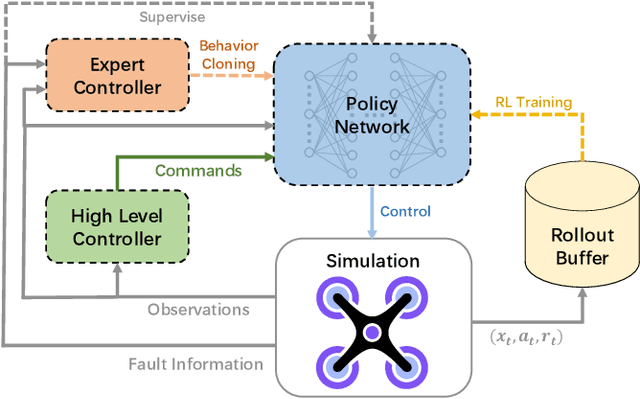
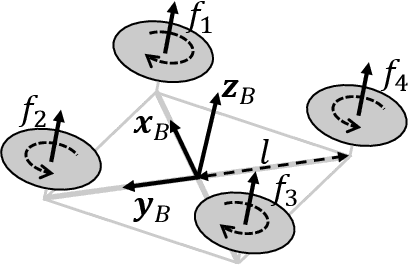

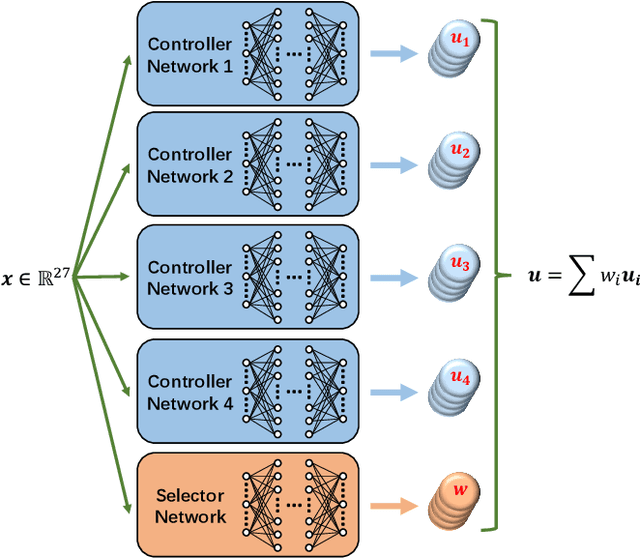
Abstract:This paper proposes a learning-based passive fault-tolerant control (PFTC) method for quadrotor capable of handling arbitrary single-rotor failures, including conditions ranging from fault-free to complete rotor failure, without requiring any rotor fault information or controller switching. Unlike existing methods that treat rotor faults as disturbances and rely on a single controller for multiple fault scenarios, our approach introduces a novel Selector-Controller network structure. This architecture integrates fault detection module and the controller into a unified policy network, effectively combining the adaptability to multiple fault scenarios of PFTC with the superior control performance of active fault-tolerant control (AFTC). To optimize performance, the policy network is trained using a hybrid framework that synergizes reinforcement learning (RL), behavior cloning (BC), and supervised learning with fault information. Extensive simulations and real-world experiments validate the proposed method, demonstrating significant improvements in fault response speed and position tracking performance compared to state-of-the-art PFTC and AFTC approaches.
SongGen: A Single Stage Auto-regressive Transformer for Text-to-Song Generation
Feb 18, 2025Abstract:Text-to-song generation, the task of creating vocals and accompaniment from textual inputs, poses significant challenges due to domain complexity and data scarcity. Existing approaches often employ multi-stage generation procedures, resulting in cumbersome training and inference pipelines. In this paper, we propose SongGen, a fully open-source, single-stage auto-regressive transformer designed for controllable song generation. The proposed model facilitates fine-grained control over diverse musical attributes, including lyrics and textual descriptions of instrumentation, genre, mood, and timbre, while also offering an optional three-second reference clip for voice cloning. Within a unified auto-regressive framework, SongGen supports two output modes: mixed mode, which generates a mixture of vocals and accompaniment directly, and dual-track mode, which synthesizes them separately for greater flexibility in downstream applications. We explore diverse token pattern strategies for each mode, leading to notable improvements and valuable insights. Furthermore, we design an automated data preprocessing pipeline with effective quality control. To foster community engagement and future research, we will release our model weights, training code, annotated data, and preprocessing pipeline. The generated samples are showcased on our project page at https://liuzh-19.github.io/SongGen/ , and the code will be available at https://github.com/LiuZH-19/SongGen .
Hybrid Adaptive Modeling using Neural Networks Trained with Nonlinear Dynamics Based Features
Jan 21, 2025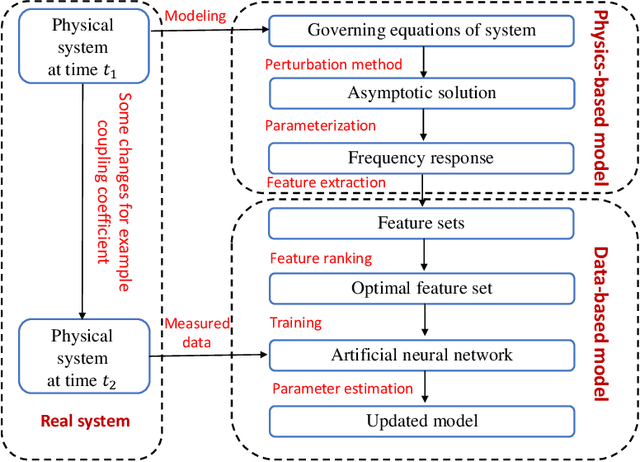
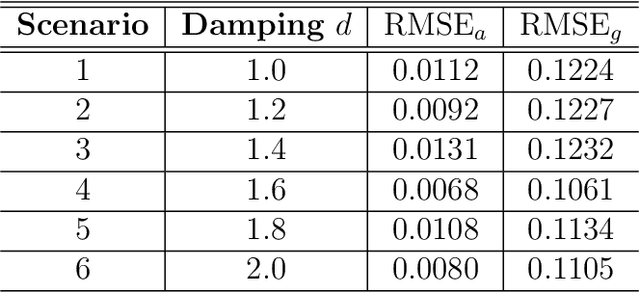
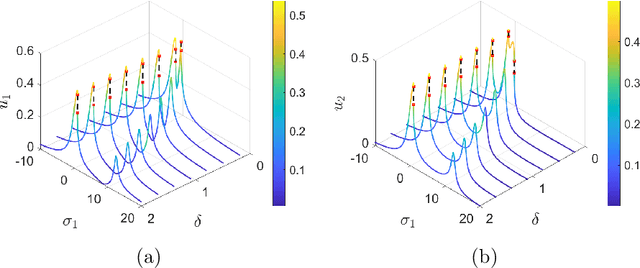
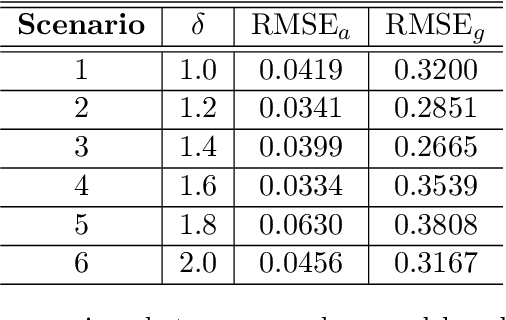
Abstract:Accurate models are essential for design, performance prediction, control, and diagnostics in complex engineering systems. Physics-based models excel during the design phase but often become outdated during system deployment due to changing operational conditions, unknown interactions, excitations, and parametric drift. While data-based models can capture the current state of complex systems, they face significant challenges, including excessive data dependence, limited generalizability to changing conditions, and inability to predict parametric dependence. This has led to combining physics and data in modeling, termed physics-infused machine learning, often using numerical simulations from physics-based models. This paper introduces a novel approach that departs from standard techniques by uncovering information from nonlinear dynamical modeling and embedding it in data-based models. The goal is to create a hybrid adaptive modeling framework that integrates data-based modeling with newly measured data and analytical nonlinear dynamical models for enhanced accuracy, parametric dependence, and improved generalizability. By explicitly incorporating nonlinear dynamic phenomena through perturbation methods, the predictive capabilities are more realistic and insightful compared to knowledge obtained from brute-force numerical simulations. In particular, perturbation methods are utilized to derive asymptotic solutions which are parameterized to generate frequency responses. Frequency responses provide comprehensive insights into dynamics and nonlinearity which are quantified and extracted as high-quality features. A machine-learning model, trained by these features, tracks parameter variations and updates the mismatched model. The results demonstrate that this adaptive modeling method outperforms numerical gray box models in prediction accuracy and computational efficiency.
 Add to Chrome
Add to Chrome Add to Firefox
Add to Firefox Add to Edge
Add to Edge